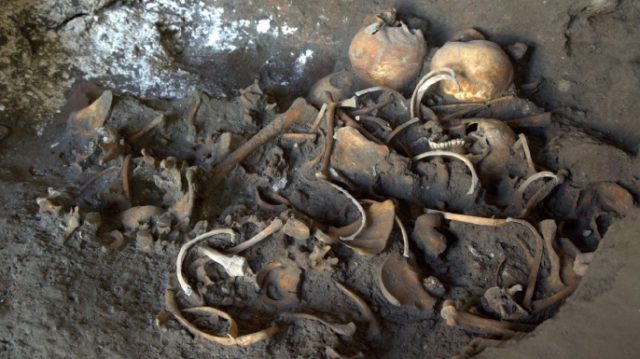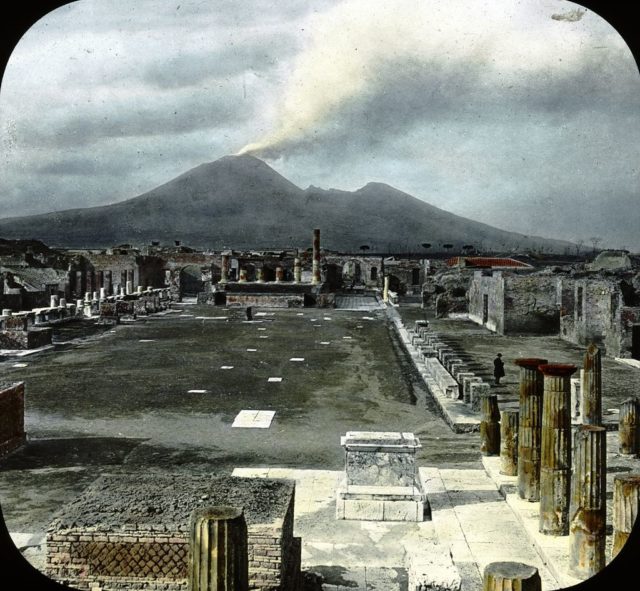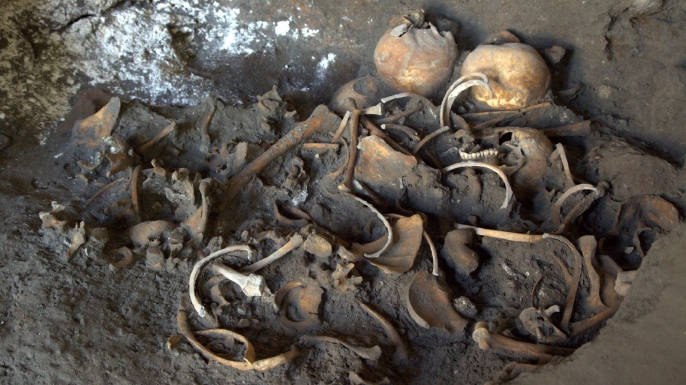An Italian and French archaeologist team has uncovered four skeletons whilst digging in the outskirts of Pompeii. The skeletons of four young people, one an adolescent girl, who perished in the back of a shop when Mount Vesuvius erupted. Gold coins were found with the human remains.
The excavation that uncovered the skeletons had begun in May. Their aim was to uncover two ancient shops that were located near a necropolis in the Herculaneum port area. The second shop to be excavated presents a bit of a mystery to researchers. The shop had a circular well accessible by a spiral staircase.
Perhaps unsurprisingly, there is evidence the shop had been ransacked by diggers after the eruption and before the official excavation. These clandestine diggers were likely on the hunt for any treasures buried under the ashes. They must not have been very good—they missed the gold coins and a gold-leaf-foil pendent, in the shape of a flower. The human remains were found in what archaeologists believe was once the workshop, where bronze objects were once made.

Archeologists made another stunning discovery during the dig. They found a 4th century BC tomb. Inside the tomb was a skeleton of an adult, possibly a male. Arranged near the arms and feet were six funerary vases, painted black. This find, according to officials, adds to the rare funerary testimony of pre-Roman age.
Pompeii, once a bustling Roman town in the Italian region of Campania, is now a UNESCO World Heritage Site and receives about 2.5 million visitors each year. After the volcano erupted, the site was abandoned until its rediscovery in 1748. It gives researchers a unique opportunity. Many of the buildings, skeletons, and artifacts were found intact under the deep layer of ash.
The eruption of Mount Vesuvius apparently caught the citizens of Pompeii unawares, according to the writings of Pliny the younger, who watched the disaster unfold from a distance. An administrator and poet, he described what he saw in letters to friends.

In these letters, Pliny described a column of smoke “like an umbrella pine” that rose from the volcano. The surrounding towns were turned black as night. People ran for their lives, holding torches, and screaming. For several hours, a rain of ash and pumice fell.
Although the eruption lasted a total of twenty-four hours, the pyroclastic surges only began at midnight. It was these surges that caused the volcano to collapse in the early morning hours. This in turn resulted in an avalanche of hot ash, rock and poisonous gas that rushed down the side of the volcano at 124 mph (199 kph), and buried the victims and remnants of everyday life.
Hundreds of refugees who sought shelter in the vaulted arcades at the seaside in Herculaneum, clutching their jewelry and money, were killed instantly. Although Pliny did not estimate how many people died, the number of deaths is now thought to exceed 10,000.
The blanket of ash that buried the citizens eventually hardened to form a porous shell. The soft tissues of the bodies decayed, leaving the skeletons intact within a void. This had not been seen before and amazed excavators. It wasn’t long before researchers were able to create plaster casts of the people who had died during the disaster.
